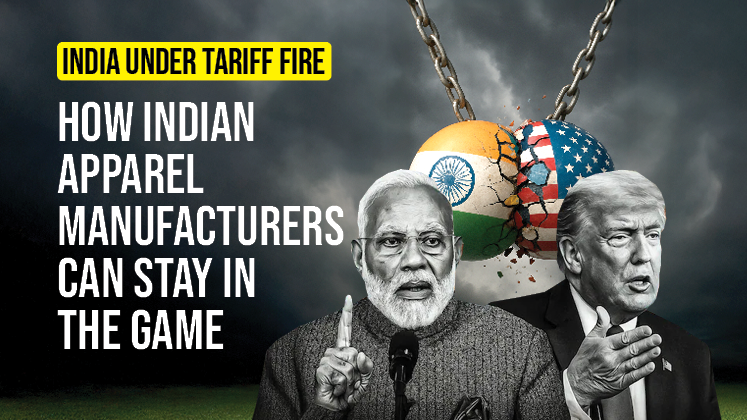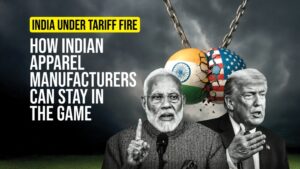In a move that could significantly alter the dynamics of global apparel trade, the United States under the Trump administration has imposed 50% tariff on Indian apparel exports –25% standard + 25% penalty for India’s continued purchase of Russian oil.
At stake? India’s nearly US $ 4.5 billion worth of apparel exports to the US and a market that currently consumes 5.8% of America’s total apparel imports.
For a country aiming to scale its textile exports to US $ 100 billion, the blow is sharp. But is this the end of the India-US apparel trade story? Not at all. In fact, this could be the inflection point for a strategic shift that redefines India’s role in global sourcing.
India’s apparel exports to the US have historically centred on both knitted and woven garments. In 2024, India exported US $ 2.14 billion in knitted garments (HSN 61) and US $ 2.53 billion in woven garments (HSN 62). These numbers reflect India’s strong position in the supply chains of several American retail giants, including Walmart, Gap, Levi’s, Macy’s and Target amongst many others.
However, the sudden tariff escalation risks are making Indian products significantly more expensive compared to those from Vietnam, Bangladesh or suppliers under CAFTA like Honduras and El Salvador. As a result, US-based sourcing heads may now re-evaluate their supplier mix and India risks losing share in its most lucrative market.
The Immediate Impact: Tariff Shockwaves
The US accounted for approximately 27% of India’s apparel exports in 2024. With the new 25% tariff regime kicking in from 1st August and another possible 25% regime from 28th August, suppliers of key HS codes like 620342 (Cotton Trousers) and 610910 (Cotton T-shirts) will now see an average increase of 63-67% in landed cost. That alone is enough for price-sensitive US brands to reassess their order placements.
Product-wise classification of tariff modifications
| HS Code | Product Description | Pre-Tariff Duty | Additional Tariff | New Total Duty |
| 620342 | Men’s/Boys’ Cotton Trousers | 15.7% | 50% | 65.7% |
| 610910 | Cotton T-Shirts | 16.5% | 50% | 66.5% |
| 620462 | Women’s Cotton Skirts | 14.8% | 50% | 64.8% |
| 610462 | Women’s Knitted Dresses | 17.1% | 50% | 67.1% |
Source: USITC and Trade Compliance Updates and Apparel Resources Analysis
While Indian exporters have weathered tariff-related disruptions in the past, this hike comes at a time when global retail demand is fragile, inventories are under tight control and brands are pushing for even leaner supply chains.
The Bigger Picture: The Rise of Decentralised Sourcing
US buyers and Indian exporters enter a new phase of negotiation
India holds cards that many competitors do not. Several US-based apparel and lifestyle brands operate retail businesses within India itself. These include giants like Nike, Levi’s, Tommy Hilfiger and Walmart (via Flipkart). For these brands, India is not just a supplier – it’s also a key retail destination. This matters greatly because India’s foreign direct investment (FDI) rules mandate that foreign single-brand retailers with 100% ownership must source at least 30% of the value of goods sold in India from within the country.
This local sourcing mandate is averaged over the first five years of operation and then becomes an annual requirement. Thus, even if US-bound sourcing is scaled back due to tariffs, local manufacturing in India will remain essential for foreign brands operating Indian retail stores.
Hence, rather than disengaging from India, most global retailers are now likely to recalibrate. They will pursue a dual-track sourcing strategy. For their US operations, sourcing may shift towards countries with lower tariff burdens. But for Indian retail operations and proximity markets – like the Middle East, Africa, Southeast Asia and Oceania – India will likely become a more strategic sourcing hub. India’s geographic position, trade agreements like the India–UAE CEPA and cultural linkages with nearby regions make it an ideal candidate for regional supply.
The conversations with US buyers are now shifting from “how much can you supply to the US?” to “can you develop region-specific assortments for our non-US markets, while maintaining cost and speed advantages?” For many Indian vendors, this will involve deeper integration into brands’ global sourcing strategies, greater flexibility in MOQs and faster sampling cycles.
Revised sourcing strategy (that might be considered by global retailers)
| Market | Preferred Sourcing Base (Post-Tariff) |
| United States | Vietnam, Bangladesh, Mexico, Central America |
| India | India (to meet FDI norms and retail demand) |
| Middle East | India (regional proximity + FTA advantages) |
| Africa | India (competitive pricing and port access) |
| Southeast Asia | India (for basics and cotton-rich products) |
| Australia/NZ | India (summer apparel and natural fibre goods) |
Data also supports this shift. According to the 2024 United States Fashion Industry Association (USFIA) survey, nearly 60% of the US fashion brands and retailers reported plans to expand sourcing from India – not for the US market but for other global operations.
Walmart, for instance, imported only 2% of its products from India in 2018; by 2023, this had jumped to 25%. It now targets US $ 10 billion worth of annual sourcing from India by 2027.
PVH, through its joint venture with Arvind Fashions, continues to retail Calvin Klein and Tommy Hilfiger in India, with Tommy alone contributing over 60% of the JV’s revenue.
Despite the new 50% US tariffs, PVH may manage cost pressures through supply-chain collaboration and selective pricing adjustments.
Gap operates in India via Reliance Retail, which handles its stores and online presence, giving it local agility to offset external shocks. While Walmart has significantly scaled up sourcing from India, brands like PVH and Gap are leveraging their India presence more for domestic retail and sourcing than exports.
Global store presence of US-based fashion retailers
| Retailer/ Brand | Global Stores (approx.) | Stores in US | Stores Outside US | Stores in India | Countries Present (approx.) |
| Levi Strauss & Co. (Levi’s) | 3,400 | 240 | 3,160 | 400+ | 120 |
| Gap Inc. (Total) | 3,560 | 2,400+ (Gap, Old Navy, Banana Republic, Athleta) | 1,140+ | 51 | 43 |
| American Eagle Outfitters | 1,000+ | 813 | 200+ | 17 (Another 30 in pipeline) | 24 |
| Nike | 1,045 | 294 | 751 | 94 | Multiple |
| Walmart | 10,771 | 5,206 | 5,454 | E-commerce (via Flipkart) | 19 |
| PVH – Tommy Hilfiger and Calvin Klein | ~2,500* | ~275 | ~2,225 | ~1,300 points of sale (including shop-in-shops and multi-brand outlets) | 100+ |
Similarly, in mid-2025, Indian apparel exports to the US by volume grew 42.1% year-on-year, reaching 7,249.7 million square metre equivalent (MSME). However, this growth trajectory may stall under the new tariffs, unless India pivots quickly.
If executed correctly, India can become the go-to manufacturing base not for US retail supply chains but for global brands seeking reliable production for Middle Eastern malls, African department stores, Southeast Asian e-commerce platforms and its own booming domestic market.
India’s comparative advantage in cotton textiles, a young labour force and a growing pool of compliant, tech-enabled factories give it the infrastructure needed to serve as a regional production leader.
To seize this moment, India must finalise its ongoing free trade agreements with the EU, UK and Canada; invest in logistics and shipping improvements and promote sustainable and circular fashion practices to appeal to environmentally conscious consumers.
Why India Is Difficult To Be Ignored?
One of India’s biggest trump cards remain product diversity. According to 2024 trade data, US imports from India spanned a significantly wider range of categories compared to most Asian peers. The Herfindahl-Hirschman Index (HHI) analysis at the 6-digit HS code level confirms India’s broad production base, offering everything from embroidered kurtas to structured formalwear to premium cotton basics.
Meanwhile, USFIA’s survey also reveals that over 15,000 SKUs labelled ‘Made in India’ were newly introduced in the US market during January-October 2024. While China dominated with 60,000 SKUs.
SKUs recently introduced in US retail market
| Country | New SKUs in US Retail (Jan–Oct. 2024) |
| China | 60,000 |
| India | 15,000 |
| Cambodia | 3,400 |
| Bangladesh | 2,900 |
| Mexico | 1,900 |
| Central America* | <1,000 |
*Includes Guatemala, El Salvador, Honduras
This SKU diversity highlights India’s flexible manufacturing ecosystem which allows retailers to co-create collections faster and pivot in-season if needed.
Also, over 45% of India’s newly introduced apparel in the US in 2024 targeted the premium and luxury segment, closely rivalling China’s 50%, outpacing Bangladesh (13%) or Vietnam (20%), reinforcing India’s perception as a ‘value-for-quality’ supplier rather than a cheap volume player.
Recent addition of premium/luxury apparel in US market
| Country | % of Premium/Luxury Apparel Launched in US (Jan–Oct. 2024) |
| China | 50% |
| India | 45% |
| Vietnam | 20% |
| Bangladesh | 13% |
| Indonesia | 18% |
| Cambodia | 5% |
Cotton Strength = Sustainability Edge
India’s cotton-rich supply chain continues to serve as the backbone for its sourcing attractiveness. In the first 10 months of 2024:
- 60% of apparel imported by the US from India contained cotton
- 13% used organic cotton, the highest amongst all Asian sourcing destinations
This fibre composition places India ahead in supplying:
- Sustainable casualwear
- Festival/seasonal cotton blends
- Embroidered or artisan-made premium collections
However, India’s relatively low use of synthetic fibres like polyester, nylon or spandex explains why product lines like outerwear or performance athleisure are still limited in scope.
The Way Forward: From Tariffs to Transformation
India’s apparel exporters now face a choice: to dwell on trade setbacks or reposition themselves as multi-market, high-value partners. The current US tariff disruption is not only a wake-up call but also a doorway to diversification, both in terms of product and market.
With Southeast Asia and the Middle East expanding their retail presence and US buyers open to redistributing India’s role across their global footprints, this is a moment to push deeper into: Product development; Small-batch agility; Regional retail alignment; and Brand partnerships.







